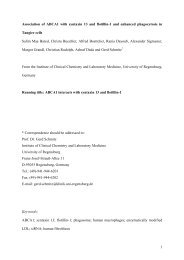SUNDAY, DECEMBER 4- Late Abstracts 1 - Molecular Biology of the ...
SUNDAY, DECEMBER 4- Late Abstracts 1 - Molecular Biology of the ...
SUNDAY, DECEMBER 4- Late Abstracts 1 - Molecular Biology of the ...
You also want an ePaper? Increase the reach of your titles
YUMPU automatically turns print PDFs into web optimized ePapers that Google loves.
<strong>SUNDAY</strong><br />
additive effectiveness with proven or suggested regenerative agents. WS1 human skin<br />
fibroblasts are seeded at a density <strong>of</strong> 105 cells/well on a 6-well culture plate. Using a 4mm<br />
sterile biopsy punch, three wound areas are created in each well at confluency. WS1 cell<br />
wounds are exposed to 10-fold serial dilutions <strong>of</strong> calcium hydroxide, avobenzene, or ZnO in<br />
appropriate solvents for 24 hours in control wells, or before cells are exposed to UVA. Effective<br />
concentrations are selected from standard dose response curves for <strong>the</strong> various regenerative<br />
reagents and are used in combination with <strong>the</strong> vitamin D3 and E isomers. During <strong>the</strong> test<br />
periods, wound areas are digitally recorded beginning at day 0, for every 12 hours over a four<br />
day period. Measurements <strong>of</strong> <strong>the</strong> radius (rw - radius <strong>of</strong> <strong>the</strong> minimal diameter <strong>of</strong> <strong>the</strong> wound), <strong>the</strong><br />
wound area (Aw) are taken using Motic 2.0 s<strong>of</strong>tware and compared to day 0 (r0 and A0).<br />
Triplicate data sets are statistically analyzed using a one-way ANOVA with Tukey’s post hoc<br />
tests. Effective concentrations <strong>of</strong> calcium/ D3 and cholcalciferol alone are seen at 10-4 mg/ml.<br />
Vitamin E isomers did improve cell proliferation and overall wound healing. The most effective<br />
doses were 10-7 mg/ml for alpha-tocopherol and 10-8 mg/ml for delta-tocotrienol, showing<br />
complete wound healing between 48 and 60 hours. It is suggested that agents with greater<br />
antioxidant activities may shorten healing times, reduce <strong>the</strong> incidence <strong>of</strong> wound infection and, in<br />
<strong>the</strong> most serious wound cases, lower <strong>the</strong> mortality rate in burn patients.<br />
2062<br />
Arp 2/3 Plays a Crucial Role in Focal Adhesion Initiation at <strong>the</strong> Leading Edge.<br />
R. J. Vasquez 1 , K. Sayegh 2 , J. Stricker 3 , Y. Beckham 3 , M. Gardel 3 ; 1 Department <strong>of</strong> Pediatrics,<br />
Section <strong>of</strong> Hematology, Oncology and Stem Cell Transplantation, University <strong>of</strong> Chicago,<br />
Chicago, IL, 2 University <strong>of</strong> Chicago, Chicago, IL, 3 Department <strong>of</strong> Physics, University <strong>of</strong> Chicago,<br />
Chicago, IL<br />
The lamellipodia is a dense, Arp-2/3 mediated actin network at <strong>the</strong> leading edge <strong>of</strong> migrating<br />
cells that generates forces sufficient to generate sheet-like protrusions <strong>of</strong> <strong>the</strong> cell edge. In<br />
addition to this force generating role, <strong>the</strong> initiation <strong>of</strong> focal adhesions also occurs within <strong>the</strong><br />
lamellipodia. However, <strong>the</strong> role <strong>of</strong> lamellipodial actin in focal adhesion initiation is not well<br />
understood. We used a recently identified inhibitor <strong>of</strong> <strong>the</strong> ARP 2/3 complex, CK 869, to<br />
investigate <strong>the</strong> role <strong>of</strong> <strong>the</strong> lamellipodia in leading edge protrusion and focal adhesion formation<br />
in cell motility and adhesion in two cell types- MCF10A cells (a human breast epi<strong>the</strong>lial cell line)<br />
and U20S cells (a human osteosarcoma cell line). We find that treatment with CK 869 disrupts<br />
or inhibits <strong>the</strong> formation <strong>of</strong> an organized lamellipod, as demonstrated by phalloidin staining and<br />
immun<strong>of</strong>luoresce with cortactin, a protein enriched in <strong>the</strong> lamellipod. Motility assays <strong>of</strong> single<br />
cells and scratch assays with MCF-10A cells demonstrate that treatment with CK-869 reduced<br />
<strong>the</strong> number <strong>of</strong> motile cells and reduced <strong>the</strong> motility rate, and in <strong>the</strong> case <strong>of</strong> <strong>the</strong> scratch assay,<br />
greatly increased <strong>the</strong> time to closure <strong>of</strong> <strong>the</strong> cell sheet. Despite <strong>the</strong>se effects on cell migration,<br />
protrusions <strong>of</strong> <strong>the</strong> cell edge persist, suggesting that ARP 2/3 mediated actin assembly is not <strong>the</strong><br />
only mechanism through which to generate sheet-like membrane protrusions. We hypo<strong>the</strong>sized<br />
that <strong>the</strong>se membrane protrusions might differ from lamellipodial protrusions in <strong>the</strong>ir ability to<br />
form new focal adhesions. Immuno-staining <strong>of</strong> <strong>the</strong> focal adhesion proteins paxillin and vinculin<br />
demonstrated that <strong>the</strong> ARP 2/3 inhibited cells had fewer but larger peripheral adhesions and<br />
fewer central focal adhesions. Live cell imaging with GFP-paxillin in U2OS cells revealed that<br />
<strong>the</strong> protrusions formed in <strong>the</strong> presence <strong>of</strong> <strong>the</strong> ARP-inhibitor revealed reduced focal adhesion<br />
assembly. Collectively, <strong>the</strong>se results indicate that ARP 2/3 is not necessary for sheet-like<br />
protrusions <strong>of</strong> <strong>the</strong> cell edge but plays a crucial role in focal adhesion formation.
















